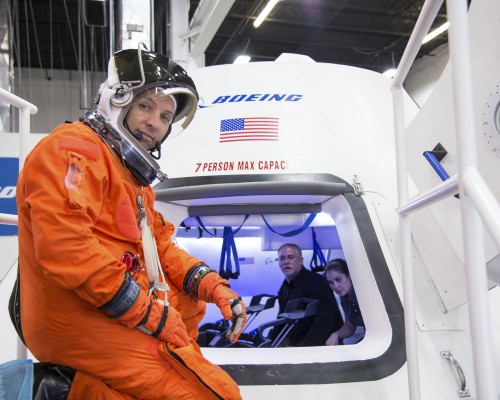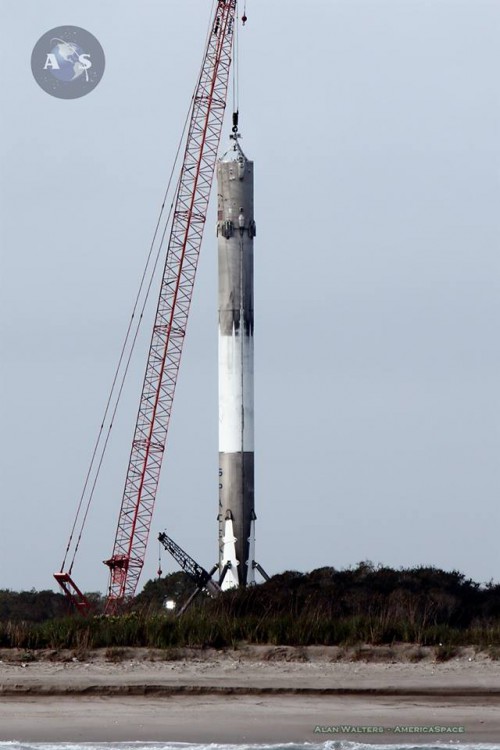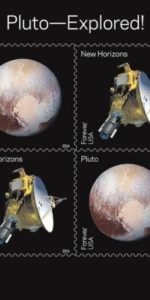
As the world bids farewell to 2015, we can reflect upon a dozen months which have seen success and failure in equal measure for America’s space program. High above our heads, unprecedented activity has been undertaken aboard the International Space Station (ISS), as NASA and its partners reconfigured the U.S. Orbital Segment (USOS) in readiness for Commercial Crew operations, whilst simultaneously running hundreds of experiments, staging seven EVAs, welcoming U.S., Russian, European and Japanese cargo ships and beginning the first one-year manned mission of the 21st century. Cumulative, national and empirical world endurance records have been set by astronauts and cosmonauts from Russia, the United States, Italy, Denmark and—having recently seen the launch of its first “official” astronaut, Tim Peake—the United Kingdom.
Elsewhere, despite a run of Congressional funding shortfalls which prompted a frustrated NASA Administrator Charlie Bolden to appeal in August directly to the leadership of the committees responsible for NASA’s budget, the Commercial Crew Program (CCP) now stands on the threshold of launching Boeing’s CST-100 Starliner and SpaceX’s Crew Dragon on their first piloted voyages a little over a year from now. After the Senate Appropriations Committee exacted a 27-percent cut from the CCP budget in June, Gen. Bolden denounced the continued lack of adequate funding for the program and announced a $490 million modification to the uneasy contract with Russia, which currently provides the United States with its sole means of getting astronauts to the ISS.

He noted that CCP reductions would “result in NASA’s inability to fund several planned CCtCap milestones in 2016”, thereby inducing additional schedule slippage and increased costs. However, the funding situation appeared to have met with kinder following winds in the latter half of 2015, as Congress fully funded the Commercial Crew Program in 2016, awarding $1.24 billion, which was the exact amount requested by President Obama. “The final budget deal comes after protracted negotiations between the House and Senate,” noted an Ars Technica article, dated 16 December. “It allocates a total of $19.3 billion to NASA for the coming fiscal year, which is $756 million above the President’s request.”
On other fronts, United Launch Alliance (ULA) closes out a 12-flight banner year of accomplishments—which included its 100th overall mission in October and its first ISS-bound mission in December—and the Space Launch System (SLS) and Orion programs continue to gain significant ground, ahead of the long-awaited Exploration Mission (EM)-1, no sooner than November 2018. The latter, which has seen the installation of SLS work platforms in the cavernous Vehicle Assembly Building (VAB) at the Kennedy Space Center (KSC), the restarting of production of Aerojet Rocketdyne’s shuttle-era RS-25 engines and a full raft of Critical Design Review (CDR) activities for both the gigantic booster itself and for the Orion hardware which will ultimately support human missions Beyond Low-Earth Orbit (BLEO), sometime after 2021.
These successes were, however, juxtaposed with disappointment and calamity, as SpaceX and Orbital ATK—both of which currently provide Commercial Orbital Transportation Services (COTS) to the space station, via their Dragon and Cygnus uncrewed cargo ships—endured and recovered from parallel losses of their Falcon 9 and Antares boosters. On 28 June, SpaceX’s Commercial Resupply Services (CRS)-7 Dragon was lost when its Falcon 9 disintegrated at high altitude, following the failure of a helium tank strut, and both the cargo ship and NASA’s first International Docking Adapter (IDA-1) were lost. Under original plans, IDA-1 would have been installed at the forward port of the Harmony node, providing a primary docking interface for Commercial Crew vehicles, with IDA-2 launched later and affixed to the space-facing (or “zenith”) port as a backup location. As a result of the 28 June failure, the IDA-2 hardware will now fulfil the “primary” IDA-1 role, when it flies in early 2016, whilst a replacement IDA-3 is currently being constructed.
Throughout 2015, the ISS has been occupied by six discrete crews, each delivered to orbit aboard Russia’s workhorse Soyuz spacecraft. At the dawn of the year, Expedition 42 Commander Barry “Butch” Wilmore was joined by his Russian crewmates Aleksandr Samokutyayev, Anton Shkaplerov and Yelena Serova, together with NASA astronaut Terry Virts and Italy’s first woman in space, Samantha Cristoforetti. In fact, 1 January 2015 marked the first occasion that as many as two women—with Cristoforetti joined by Serova, only the fourth Russian female cosmonaut ever to fly into space—had been in orbit together over the New Year period.
Although a relatively minor record, it certainly set the tone for the remarkable 12 months which would follow. In addition to a full plate of research payloads, Wilmore and Virts performed three complex EVAs in February-March to establish the Common Communications for Visiting Vehicles (C2V2) architecture, lay power and data cables in readiness for the arrival and installation of two Boeing-built International Docking Adapters (IDAs) onto the station’s Harmony node for Commercial Crew operations and perform the first of two sessions of lubricating the 57.7-foot-long (17.6-meter) Canadarm2 robotic arm.

Upon the return to Earth of Wilmore, Samokutyayev and Serova aboard Soyuz TMA-14M on 11/12 March, Terry Virts assumed command of the ISS and Expedition 43 got underway. Three weeks later, his crew was joined by Russian cosmonauts Gennadi Padalka and Mikhail Kornienko, together with NASA’s Scott Kelly, who launched from Baikonur Cosmodrome in Kazakhstan aboard Soyuz TMA-16M, kicking off the first one-year mission of both the ISS era and the 21st century.
The opening weeks of Expedition 43 ran with exceptional smoothness and the six-strong crew welcomed the station’s second SpaceX Dragon visitor of the year and prepared for the arrival of Russia’s Progress M-27M cargo ship in late April. The highly successful Progress, which can trace its ancestry back to the 1970s, had supported its 60th ISS-bound flight, earlier in 2015. However, a launch vehicle failure doomed Progress M-27M—which re-entered the atmosphere a few days later—and the resulting investigation into the cause of the accident caused several other missions, including the piloted Soyuz TMA-17M, which employed a similar booster, to be postponed. With Soyuz TMA-17M pushed from late May until the end of July, it was highly undesirable to bring Virts, Shkaplerov and Cristoforetti home as planned on 14 May and leave the ISS at a reduced manpower of just three crew members (Padalka, Kornienko and Kelly) for more than two months.

As a result, Virts’ expedition was extended by four weeks, thereby narrowing the gap at reduced capability, and when his crew finally returned to Earth aboard their Soyuz TMA-15M spacecraft on 11 June, they had accrued almost 200 days in space, marking the second-longest mission of the ISS era and cementing Cristoforetti’s credentials as holder of the record for the longest single flight ever undertaken by a woman and, by default, making her the most space-experienced Italian citizen.
These records continued to fall like ninepins as 2015 wore on. Gennadi Padalka was already one of the world’s most seasoned spacefarers when he rose to orbit in March. Three months later, on 28 June, the very day that SpaceX lost its CRS-7 Dragon, Padalka eclipsed fellow cosmonaut Sergei Krikalev’s 803-day career accomplishment and became the new record-holder for the longest period of time cumulatively spent in space. By the time he returned to Earth in September, Padalka had accrued 878 days aloft, across his five missions, which represented about 2.4 years of his life, a record which seems unlikely to be broken for the foreseeable future.
Returning to Earth with Padalka was Denmark’s first astronaut, Andreas Mogensen, who established himself by default as the most experienced of his countrymen, with an opening career total of almost ten days. More national records were established as the year wore on, when Scott Kelly became the first American to serve two consecutive ISS expedition commands in September, before going on to eclipse Mike Fincke’s 381-day cumulative U.S. record and Mike Lopez-Alegria’s 215-day single-mission U.S. record in October. By the time Kelly and Kornienko return to Earth in March 2016, after 342 days, they will have flown the fourth-longest single space mission in history.
As ISS operations continued, so too did efforts to restore America’s capability to deliver its astronauts to the space station, aboard a homegrown spacecraft, and from home soil, for the first time since the end of the Space Shuttle era. Following 2014’s selection of SpaceX and Boeing as joint winners of the $6.8 billion Commercial Crew transportation Capability (CCtCap) contracts, both commercial providers stormed ahead with their efforts to build their Crew Dragon and CST-100 Starliner vehicles and the associated ground-support infrastructure.

On 6 May 2015—as highlighted in a Photo Feature by AmericaSpace’s imagery team—SpaceX staged the long-awaited Pad Abort Test (PAT) milestone for its Crew Dragon from Space Launch Complex (SLC)-40 at Cape Canaveral Air Force Station, Fla., spectacularly demonstrating the ability of the eight SuperDraco thrusters to pull the spacecraft to safety in the event of a launch malfunction. This success later secured SpaceX a $30 million milestone payment from NASA as the Hawthorne, Calif.-based launch services provider seeks to fly a 14-day unpiloted Crew Dragon to the ISS as early as December 2016, followed by a 30-day crewed test flight in April 2017.
In tandem with these developments, in July 2015 NASA announced the names of shuttle and ISS veterans Suni Williams, Eric Boe, Doug Hurley and former Chief Astronaut Bob Behnken to form the first training group for Commercial Crew missions. Under the terms of the CCtCap agreements, after conducting their inaugural unpiloted and crewed test flights, SpaceX and Boeing will stage a minimum of two and a maximum of six “Post-Certification Missions” (PCMs) to the station to perform crew-rotation activities.

The first mission, designated “U.S. Crew Vehicle-1” (USCV-1), is expected to fly no sooner than May 2018, and will include a crew of four astronauts and cosmonauts, together with about 220 pounds (100 kg) of pressurized cargo. Although no decision has yet been made as to whether SpaceX or Boeing will draw the coveted first flight, both companies close out 2015 in receipt of formal PCM orders. Boeing received two orders, one in May and another in December, whilst SpaceX received its first PCM in November.
Both sets of orders came about following the successful passing by SpaceX and Boeing of several interime development milestones and internal design reviews of their respective spacecraft, as well as the steadily rising infrastructure which will soon support the return of U.S. astronauts to space from Cape Canaveral. As described by AmericaSpace’s Mike Killian earlier this year, Space Launch Complex (SLC)-41 at Cape Canaveral Air Force Station, Fla.—from which site Atlas V 422 boosters will deliver CST-100 Starliners into orbit—is receiving significant enhancements to render it capable of supporting human missions, including a 200-foot-tall (60-meter), seven-tiered Crew Access Tower. Concurrently, the CST-100 Starliner processing facility was taking shape, inside the confines of the Commercial Crew and Cargo Processing Facility (C3PF), which was formerly one of three Orbiter Processing Facilities (OPFs) during the 30-year shuttle era.
Meanwhile, in mid-September SpaceX successfully tested the enhanced Merlin 1D+ engines for its Upgraded Falcon 9 booster—known informally as “Full Thrust” and capable of a full, 100-percent propulsive yield, as opposed to the approximately 80 percent previously achievable—and pressed ahead with major modifications at the historic Pad 39A site, which now boasts a large Horizontal Integration Facility (HIF) and which will be employed from 2016 to launch the mammoth Falcon Heavy booster for the first time. In fact, the recently-returned first-stage core of the inaugural Upgraded Falcon 9 was transported to Pad 39A last week for a series of modifications, fluid and electrical checks, propellant loading and ultimately a static test-firing of the nine Merlin 1D+ engines. However, SpaceX CEO Elon Musk has already clarified that he does not intend to re-use this historic vehicle.
And this ability to return a rocket’s first stage from the edge of space to a pinpoint (and intact) landing on solid ground is not only a pinnacle accomplishment of 2015, but a historic event for the space program as a whole. As part of SpaceX CEO Elon Musk’s effort to enhance the reusability of the Falcon 9, and thereby drive down the cost of launching payloads into space, efforts have been undertaken in recent years—most visibly through the Grasshopper demonstrator and oceanic landings aboard the Autonomous Spaceport Drone Ship (ASDS) in the Atlantic Ocean—to bring the booster’s first-stage hardware safely back to Earth through a series of high-altitude engine manuevers, lattice-like hypersonic grid fins and a framework of landing legs.

Two attempts to land returning Falcon 9s on the ASDS earlier in 2015 met with partial success. Both hit their target, but ultimately toppled over and exploded, due to premature exhaustion of hydraulic fluid in the grid fins during a first attempt in January and suffering excessive lateral velocity in the final seconds of descent during a second attempt in April.
As SpaceX worked through the summer and into the fall, readying its Falcon 9 for a Return to Flight (RTF), it also became abundantly clear that the company was seeking to land the booster hardware not on the ASDS, but on solid ground, alighting at Landing Complex (LC)-1 at Cape Canaveral Air Force Station, a repurposed Atlas launch site, previously out of operational use for more than three decades. Early in December, the Air Force confirmed that SpaceX was awaiting Federal Aviation Administration (FAA) approval to attempt a “land” landing and a few days later it was confirmed that the Falcon 9 core would indeed attempt to touch down on LC-1. With the echoes of 28 June’s castastrophic launch failure still fresh in many minds, few could have anticipated the spectacular success that occurred during a mere ten-minute period from 8:29 until 8:39 p.m. EST on 21 December, as the first-stage core completed its job of delivering 11 Orbcomm Generation-2 (OG-2) satellites towards low-Earth orbit, then flipped itself over and boosted itself back to Earth, reaching the landing zone with pinpoint accuracy and in scorched, though otherwise near-perfect, condition.

SpaceX’s success comes a few weeks after Jeff Bezos, CEO of Kent, Wash.-headquartered Blue Origin, announced success as his company’s New Shepard suborbital booster—which had passed a series of critical tests of its BE-3 liquid-fueled engine, earlier in 2015—rose from its West Texas launch site on 23 November and ascended to an altitude of 329,829 feet (100.5 km), before returning to land in one piece on solid ground. “The rarest of beasts, a used rocket,” Mr. Bezos exulted, noting the New Shepard had returned to alight only 4.5 feet (1.3 meters) from the center of the launch pad. However, as outlined by AmericaSpace’s Talia Landman, New Shepard’s success actually came three years after SpaceX had demonstrated Vertical Takeoff and Landing (VTOL) on six Grasshopper missions. “The comparision between SpaceX’s Falcon 9 and Blue Origin’s New Shepard is that the latter is only designed to take humans to suborbital space,” she wrote. “The rocket doesn’t have the power to reach orbit or reach much past the 62-mile (100 km) boundary of space, because it’s not designed to do what the Falcon 9 does.”
That said, in September 2015 Blue Origin partnered with Centennial, Colo.-based ULA to expand the development of its BE-4 engine—powered by liquid oxygen and Liquefied Natural Gas (LNG)—as the primary first-stage powerplant aboard the forthcoming Vulcan heavy-lift booster, which has been described as a “game-changer”, with the capability to deliver payloads to destinations from low-Earth orbit to the outer reaches of the Solar System. The Vulcan, whose design ULA CEO Tory Bruno unveiled in April of this year, will produce 1.1 million pounds (500,000 kg) of thrust at liftoff from its dual BE-4 engines and is expected to be ready for a maiden voyage by 2019, before achieving partial reusability of its hardware later in its career. ULA had begun exploring the merits of developing the new booster in 2014, following Russia’s annexation of Crimea and invasion of eastern Ukraine and subsequent U.S. Government efforts to impose restrictions on the purchase of Russian-built RD-180 engines, a ban which was eventually lifted in December 2015.
As the curtain falls of this most momentous of years, great promise exists for 2016. In tomorrow’s article, AmericaSpace will look ahead to the plans for the New Year, as ULA prepares for up to 13 launches—nine Atlas Vs and four Delta IVs, including one flight of the Delta IV Heavy—to deliver a smorgasbord of satellite payloads, from reconnaissance to surveillance, navigation to military communications and meteorology to missile early-warning, as well as a second ISS-bound Cygnus in March and the Origins, Spectral Interpretation, Resource Identification, Security, Regolith Explorer (OSIRIS-REx) to Comet Bennu in September. Having recovered from its October 2014 loss of its Antares booster, Orbital ATK plans to launch its upgraded Antares 230 in May 2016, whilse SpaceX expects to stage the maiden voyage of its long-delayed Falcon Heavy before mid-year. Against this backdrop, continued operations aboard the ISS are expected to span Expeditions 46 through 50, with a heavy emphasis upon science and cargo resupply and preparations for Commercial Crew operations in 2017 and beyond.
Our “2015 Planetary Science Year in Review” will publish tomorrow, highlighting the success of New Horizons, Cassini, Curiosity and Opportunity, as well as other missions spread across the solar system.
WATCH: 2015 AmericaSpace Year in Review
.
Be sure to “Like” AmericaSpace on Facebook and follow us on Twitter: @AmericaSpace
.






Thank you Ben Evans for this informative review article for 2015! I’m looking forward to tomorrow’s ‘2015 Planetary Science Year in Review’ article.
What a busy and productive year for exploring space 2015 has been!
Sure was. And the way the year was closed out. I’m still trying to catch up on the news articles.